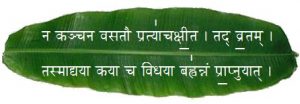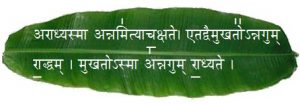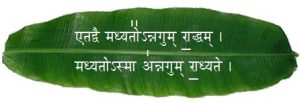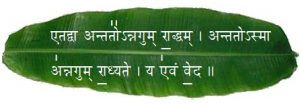परिषॆचनम
“bhOjanam” means enjoying food or giving food.
“pariShechanam” means sprinkling water around (for purifying and fortifying the food).
“bhOjanam”:
Eating food fills the hungry stomach, gives us nutrients but the vEdAs have given a very high place for food. It is not just a repetitive physical act. There seems to be more to it.
# taittireeya upaniShad bhruguvalli 3.2 says:
A³ÉýÇ oÉë¼ãÌiÉý urÉþeÉlÉÉiÉç |
annam brahmeti vyajanAt |
Food is Brahman.
# taittireeya upaniShad 3.7 says:
1. A³ÉýÇ lÉ ÌlÉþl±ÉiÉç | iÉSèuÉëýiÉqÉç |
annam na nindyaat | tadvratam |
Do not criticise food. Take it as a vow.
# taittireeya upaniShad, bhruguvalli 3.8 says
1. A³ÉýÇ lÉ mÉËUþcɤÉÏiÉ | iÉSèuÉëýiÉqÉç |
annam na parichaksheet | tadvratam |
Do not reject/waste food. Take it as a vow.
# taittireeya upaniShad, bhruguvalli 3.9 says
1. A³ÉýqÉç oÉýWÒû MÑüþuÉÏïiÉ | iÉSèuÉëiÉqÉç |
annam bahu kurveet | tad vratam |
Food should be prepared not only for your self but also for others.
So with the ultimate Brahman in mind, the “bhOjana vidhi” has been prescribed by our sages. The prAnA, life force which is essential for all the functions in the body are strengthened with mantrAs. “bhOjanam” is therefore called “prANAgnihOtrA”. “agnihOtrA” means the oblations to the Supreme Lord. “prANAgnihOtrA” means the oblations to the “prAnA”, the vital force of the “AtmA”, for which the hOma kund is the stomach, the digestive fire is jATarA agni and the oblation is the food. (Ahuti)
“pariShEchanam”
Such food that goes as an oblation to “prANA” has to be purified with water and mantrAs. This is called “pariShEchanam”. This karmA can also be construed as a part of bhakti yOgA, as all acts are a worship of the omnipresent Lord krishnA.
Lord KriSHNA in the “bhagavat geetA” says in Chapter 15, verse 14:
AWÇû uÉæµÉÉlÉUÉå pÉÔiuÉÉ mÉëÉÍhÉlÉÉÇ SåWûqÉÉÍ´ÉiÉ: |
mÉëÉhÉÉmÉÉlÉxÉqÉÉrÉÑ£ü: mÉcÉÉqrɳÉÇ cÉiÉÑÌuÉïkÉqÉç ||
aham vaishvaanarO bhootvaa praaNinaam dEhamaashrita: |
praaNaapaanasamaayukta: pachaamyannam chaturvidham ||
Having become vaishvAnara (fiery power), I exist (aashritaha) in the body (dEham) of living creatures (praaNinaam); and, acting through praaNa and apaana which I keep in balance (samaayuktaha), I digest (pachaami) food that is eaten in four ways.(chaturvidham)
1. चर्व्य- charvya – food that is chewed.
2. चूष्य – chooshya – food that is sucked.
3. लेह्य – lEhya – food that is licked.
4. पेय – pEya – food that is drunk.
One who has been initiated through the “upanayanam” samskArA should start doing “pariShEchanam”.
1. Before we start the meal, a line of water is drawn as a boundary around the banana leaf/plate to basically avoid crawling insects which may enter the food in the gross sense. In the subtle sense, its a way of honouring the food and fortifying it with goodness. While doing “parishEchanam” in the morning , the first part is called आपॊशनं- ApOshanam.
1. We first sprinkle the food with water reciting the gAyatri mantrA in order to offer our food to the “antaryAmi” bhagavAn who resides within us.
2. SåuÉ xÉÌuÉiÉ: mÉëxÉÑuÉ
deva savita: prasuva.
“Oh food, who has been given birth by the dEva savitA”
3. xÉirÉÇ iuÉiÉåïlÉ mÉËUÌwÉgcÉÉÍqÉ | (xÉirÉqÉç + iuÉ + GiÉålÉ)
satyam tvartEna pariSHinchaami.
You are true(satyam). I encircle you with (water) divine righteousness.
For dinner after 5 o’clock-
GiÉÇ iuÉÉ xÉirÉålÉ mÉËUÌwÉgcÉÉÍqÉ |
rutam tvaa satyEna pariSHinchaami |
Oh food, You are divine righteousness (rutam), I encircle you with water that is true(satyam).
4. AýqÉ×ýiÉÉåýmÉýxiÉUþhÉqÉÍxÉ | (AqÉ×iÉ + EmÉxiÉUhÉqÉç + AÍxÉ)
amrutOpastaraNamasi.
Oh water, be a substratum to the food (amRutam).
2. The second part of the “pariShEchanam” is called “prANAhuti”. Praanaahuti is an offering to the vital breaths/airs.
PrAna , apAna, vyAna, samAna and udAna are the five vital manifestaions of the Supreme which are essential for the body. We welcome the 5 praanaas and with each grain of boiled rice we satisfy the 5 prAnAs and the Brahman who exist in our body, by saying “svAhA” which means “Hail unto thee”.
1. “PraaNa vAyu ” is the principal breath which flows in , first involved in respiratory and heart functions.
2.” apAna vAyu” is the breath which flows down, responsible for the excretory system.
3.” samAna vAyu” is the breadth that circulates around the navel region, responsible for the digestive system.
4. “vyAna vAyu” is responsible for the circulatory system, it is present all over the body.
5. “udAna vAyu” is responsible for the nervous system system, moves from cenre of the body to the head..
3. The third part is called “uttarApOshanam”. After eating the meal we say,
AýqÉ×ýiÉÉýÌmÉýkÉÉýlÉqÉþÍxÉ | (AqÉ×iÉqÉç + AÌmÉkÉÉlÉqÉç + AÍxÉ)
amrutaapidhaanamasi |
Oh! water, Be a covering to the amrutam (i.e. food)”apidhaanam” means cover.
samvartta smriti Chapter 1.12 says:
सायं प्रातर्द्विजातीनामशनं श्रुतिचॊदितम् ।
नन्तरा भॊजनं कुर्य्यादग्निहॊत्रसमॊ विधि: ॥
saayaM prAtardvijAteenAmashanaM shrutichOditam |
nantarA bhOjanaM kuryyAdagnihOtrasamO vidhi: ||
shRutis have sanctioned taking meals 2 times a day (in the morning and in the evening). No meals should be taken in the interval. The rule in this respect is like that of “agnihOtrA”.(which is done 2 times). So pariShEchanaM is also done before and after the 2 meals.
Today, breakfast, lunch and dinner are an integral part of life. We can atleast do the “pariShEchanam” whenever we eat boiled/cooked rice.
1. The wife of the householder or the ladies should wipe the eating place with water.
2. Then a leaf/plate is to be placed above the eating place.
3. Leaves of the following trees can be used for eating food:
1. जम्बू (jamboo/jambul/naaval)
2. पनस (jack fruit/palaa)
3. नालिकेर (coconut/tennai)
4. आम्र (mango)
5. कदली (plantain/banana)
6. पद्म (lotus leaf)
7. प्लाक्ष (the common fig fruit tree/atti)
4. One should wash his 2 legs, 2 hands and his mouth before eating.
5. He can eat facing East, West, or the direction of the sun.
6. He should then do prOkshaNam on the leaf, by sprinkling water on it saying “Om, bhoor, bhuva : suva: ”
7. The left hand should not rest on the floor while eating.
8. The mantrAs follow in “My pariShEchanam” section.
Please click on it to get your personalised procedure online and on pdf.
Taittireeya Upanishad, Bhruguvalli 10 describes in detail how the food should be offered to the guest and how it returns to the giver.
One should not refuse food to anyone at his home. Take it as a vow. He should therefore acquire abundant food.
Food should indeed be prepared to serve guests. Food prepared and served in the best manner returns to the giver in the best manner.
Food prepared and served in a mediocre manner returns to the giver in the mediocre manner.
Food prepared and offered in the lowest manner returns to the giver in the lowest manner. One who know this is benefited accordingly.






